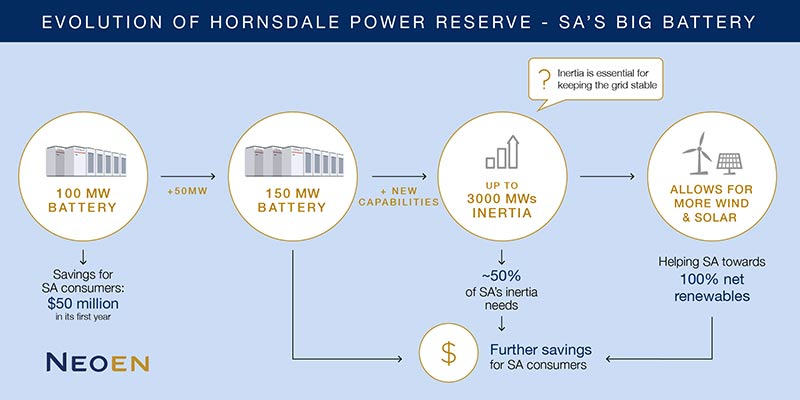Tesla’s ‘Big Battery’ in South Australia is about to get 50pc bigger
Energy
Energy
A $71m expansion to boost the Hornsdale power reserve to 150 megawatt (MW) will help improve stability of the South Australian grid, operator Neoen said on Tuesday.
Stationary storage systems are big batteries often designed to store excess power from the power grid — including from renewable sources — for use during expensive peak demand periods.
Hornsdale, also known as ‘Tesla’s Big Battery’, was a trailblazer, much maligned and misunderstood early on:
Matt Canavan, Australia’s minister for resources, is dismissive of the large Tesla battery in South Australia. “It’s the Kim Kardashian of the energy world: it’s famous for being famous. It really doesn’t do very much.” #CERAWeek2018
— Ed Crooks (@Ed_Crooks) March 7, 2018
In 2017, Scott Morrison derided the SA Tesla battery, saying it would become a “big banana”. The joke’s on him. It has returned a third of its cost in 12 months, and is now considered a big success. #auspol pic.twitter.com/MYEZUWbwen
— Eddy Jokovich (@EddyJokovich) October 1, 2018
But since then, the positive impacts of the battery’s services have well and truly been recognised.
In December 2018, for example, it was revealed that Hornsdale had already saved $40m in wholesale market costs after just one year in operation.
The current 50MW/64.5 megawatt-hour (MWh) expansion, supported by Tesla, will further showcase the benefits that grid-scale batteries can provide to the National Electricity Market (NEM), Neoen says.
The expansion will provide an Australian-first large-scale demonstration of the potential for battery storage to provide ‘inertia’ to the network.
Like a car’s suspension smoothing the ride on a dirt track, inertia services stabilise the grid when electricity supply and demand fluctuate.
At 3,000MWs, the expanded 150MW Hornsdale could match half of South Australia’s inertia needs.

Cash for the expansion is coming from the state government ($15m), the Australian Renewable Energy Agency ($8m), and the Clean Energy Finance Corporation (CEFC) (up to $50m).
“By delivering the first project financing of a stand-alone NEM-connected battery in the Australian market, our goal is to demonstrate the market potential of grid technologies for other investors and developers,” CEFC’s chief executive Ian Learmonth says.
“We are increasingly working with market participants to develop long-dated opportunities around grid augmentation, including transmission, interconnectors and renewable energy zones, as well as hydro, grid-scale battery storage and hydrogen.
“We are excited by the potential to follow this first investment in the Hornsdale Power Reserve with investments in other innovative technologies to accelerate our transition to a low emissions electricity grid.”